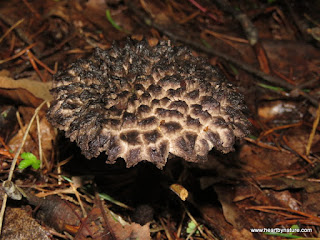I TOOK A WALK TODAY....and thought, "What a great summer to be a Mycologist!"
While strolling along the upper prairie and into the woods this morning, I couldn't take more than four steps without having a colony of mushrooms at or near my feet. The forest floor is coated with them, all at various stages in their short life cycles. I have never seen so much fungi my life!
All the wet weather we have had in Ohio this summer is to blame...or thank. And you know it's wet when even the fungus has fungus growing on it!!
Mushrooms can seem magical...just a small ball crowning the surface of the leaf litter...and the next day it's a full blown toadstool! This is especially true after a rain because for mushrooms all you need to do is "just add water!" Unlike plants and animals, the fruit of the fungus (what we call a mushroom) does not grow by cell division at its early stage...it grows by cell expansion, as water fills each compacted cell it already possesses. Nature's sponges.
The true mushroom or fungal body actually lies beneath the fruit, spreading underground or within wood. Like the apple and its tree, the mushroom is connected to tiny "branches" or filaments called hyphae, that acquire and store nutrients as they break down organic matter. Because they gather and store nutrients this way, instead of through chlorophyll and photosynthesis, they are called saprophytic organisms.
Some mushrooms have a special relationship with trees and shrubs, penetrating their roots and delivering nutrients like phosphorus and nitrogen, while taking carbohydrates and moisture from them This mutually beneficial relationship is called a mycorrhizal association.
Mushrooms are not only full of B vitamins (some are a favorite food of the box turtle), hold moisture, and recycle decaying organisms...they are also ephemerally beautiful. Below is a gallery of a few more responding to the recent rainfall. You don't need to know their names to enjoy their beauty or appreciate their role in the ecosystem.












No comments:
Post a Comment